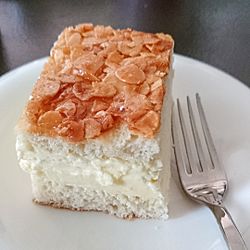Bienenstich facts for kids
 |
|
| Alternative names | Bee sting cake |
|---|---|
| Course | Dessert |
| Place of origin | Germany |
| Main ingredients | Yeast dough, almonds, vanilla custard, buttercream or cream |
Bienenstich (say "BEE-nen-shtich"), also known as bee sting cake, is a yummy German dessert. It's made from a sweet yeast dough, which is a special kind of dough that rises and becomes fluffy. On top, it has a crunchy layer of almonds that are cooked with caramelized sugar. Inside, the cake is filled with creamy vanilla custard, buttercream, or fresh cream.
This delicious cake became popular in Germany and Switzerland around the early 1900s. Before that, it was hard for most homes to keep cakes with cream fillings fresh, because they didn't have refrigerators.
One popular story about Bienenstich comes from the 15th century. It says that German bakers used beehives to scare away attackers from a nearby village. After they successfully defended their town, they celebrated by baking a cake and named it after their "bee sting" efforts!
To make this cake, a sweet yeast dough is rolled out onto a baking tray. Before it's baked, a special topping is spread over it. This topping is made by boiling sugar or honey with fat, cream, and sliced almonds. This mixture is put on the dough while it's still warm so it spreads easily. After baking and cooling, the cake is cut in half horizontally. Then, the creamy filling is added in the middle.
Name origin
The exact reason why this cake is called "Bee Sting" is not fully clear. However, there is a famous legend that explains the name.
The Baker's Boy Legend
The legend tells a story from 1474 in a German town called Andernach. The people of a nearby town, Linz am Rhein, planned to attack Andernach. This was because the Emperor had taken away their right to collect a toll (a fee) on the Rhine River and given it to Andernach.
On the morning of the planned attack, two baker's apprentices from Andernach were walking along the city wall. They were eating honey from bee nests hanging there. Suddenly, they saw the attackers from Linz approaching! Thinking quickly, the apprentices threw the bee nests at them. The attackers, stung by the bees, had to run away.
To celebrate their clever defense, the people of Andernach supposedly baked a special cake. They named it the "bee sting" cake to remember how the bees helped them.
Historical facts about the name
While the baker's boy legend is fun, it probably came about much later than the cake itself. Cakes with perishable cream fillings, like Bienenstich, needed cool storage. This kind of storage was not common in most homes until the 19th century. Most cream cakes we know today became popular in the 1800s.
Bienenstich cake is known to have existed in the German Empire shortly after 1900. Early recipes might not have even had a filling. For example, a German magazine in 1914 specifically mentioned that "Sometimes the bee sting is also filled," suggesting it wasn't always the case. Later, baking companies like Oetker helped make the cake more famous, describing it as "suitable for every season" and "not yet generally known." They also pointed out that a buttercream filling could be used.
See also
 In Spanish: Bienenstich para niños
In Spanish: Bienenstich para niños

